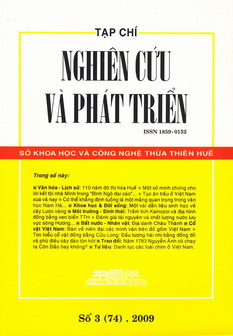110 năm đô thị hóa ở Huế/110th Anniversary of Urbanization of Hue
Tóm tắt
Huế là một trong những đô thị lâu đời ở Việt Nam, nhưng quá trình đô thị hóa ở đây diễn ra chậm chạp trên một quy mô khá khiêm tốn so với vị thế của nó trong lịch sử. Việc xác lập không gian hành chính đô thị cụ thể bằng sự ra đời thị xã Huế qua Quyết định của Toàn quyền Đông Dương ngày 30/8/1899 đã góp phần không nhỏ vào việc đẩy mạnh quá trình đô thị hóa ở Huế. Kể từ đó, đô thị Huế mới thực sự bước vào tiến trình đô thị hóa, được tổ chức, quản lý và phát triển dựa trên nền tảng mới; diện mạo đô thị bắt đầu có những thay đổi đáng kể, địa giới hành chính đô thị được điều chỉnh liên tục bằng sự sáp nhập dần vùng ven vào đô thị Huế.
Từ năm 1899 đến nay, động lực của quá trình đô thị hóa vùng ven ở Huế chủ yếu là nhu cầu mở rộng địa giới hành chính tương xứng với vị thế đô thị trung tâm chính trị Trung Kỳ, rồi đô thị tỉnh lỵ, chứ chưa phải do áp lực quá lớn từ sự trỗi dậy về kinh tế-xã hội của Huế và vùng ven. Do vậy, đô thị Huế dẫu được công nhận đô thị loại II từ năm 1993, và đến 24/8/2005 được Chính phủ công nhận là đô thị loại I trực thuộc tỉnh; vẫn thể hiện sự chậm chạp trong quá trình đô thị hóa vùng ven ở Huế thông qua sự bó hẹp của địa giới hành chính đô thị sau 110 năm thiết lập.
Nếu xem Kinh Thành Huế là cái rốn của đô thị Huế thời Nguyễn, thì hướng mở rộng không gian trong quá trình đô thị hóa vùng ven ở Huế rất hạn chế, chủ yếu chỉ mở ra theo hai hướng đông và nam. Yếu tố “thị” gắn liền với hệ thống sông nước đã lái quá trình đô thị hóa vùng ven Huế theo hướng đông; còn tác động của sự thống trị của người Pháp lại dẫn dắt quá trình đô thị hóa theo hướng nam, với tâm điểm là khu hành chính ở bờ nam sông Hương. Vì thế, phía tây và phía bắc sát nách Kinh Thành là những khoảng trống đô thị mênh mông đáng suy gẫm, chưa nằm trong bản đồ phát triển của đô thị Huế.
ABSTRACT
Huế is an age-old city in Vietnam, but its process of urbanization took place at a slow speed and on a fairly small scale, considering its historical role. The decree of the Governor-General of Indo-China, dated August 30,1899, that helped determine the initial urban structure of the city, contributed to strengthening the urbanization of the place. Ever since, Huế has been involved in urbanizing campaigns with new method of organization and management, and new guideline of development; The form of the city keeps changing remarkably; Its boundary has been constantly readjusted with the assimilation of more and more of its outskirts into the place.
Ever since 1899, the motive for the urbanization of the outskirts of Huế has always been based mainly on an intention to enlarge the administrative area of Huế so as the city should be proportioned to its position as the administrative center of the then Central Part of Vietnam, An Nam, then afterwards as a provincial capital. This urbanization is not motivated by the demands of any socio-economic development of the place and its outskirts. This is the reason why, though the city was recognized as a second-rank city in as early as 1993, and as one of the first-rank cities governed by the province on 24 August, 2005, its outskirts are still subject to a very slow urbanization process due to the fact that the area of the city still remains small after 110 years of its existence.
If we hold the Citadel of Huế as the center of the city during the Nguyễn Dynasty’s times, it can be seen that the extension of the area of Huế proves very limited, mainly directed to the east and the south, with its hub being the administrative zone on the southern bank of the Perfume River. This leaves the area to the north and the west, next to the citadel, an untouched area, seemingly excluded from the development plan of Huế.

